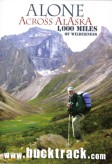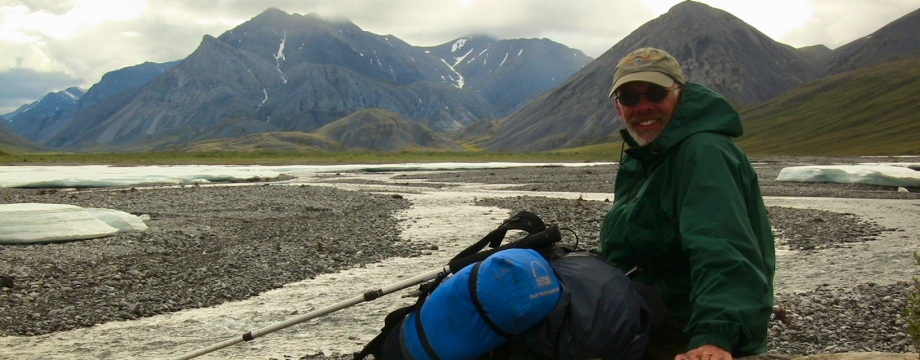Alaska Traverse: Questions and Answers
How heavy was your pack?
My maximum pack weight was about 43 pounds, starting on the first day of the trip. After the first couple of days, I don’t think it ever got over 40 lbs, with the possible exception of when I left Anaktuvuk Pass. It got down to about 20 pounds as I neared my caches, I planned for somewhat more food than I needed. I ended up actually packing about 2 pounds of food per day. I carried food such as dried fruit, dried vegetables, jerky, granola, margarine, instant rice and instant potatoes, oatmeal, cheese, crackers, grits, nuts, chocolate, peanut butter, breakfast bars, etc. Starting at the end of July, I began eating ripe blueberries. On the Noatak, I ate several meals of char and grayling.
How did you get your pack so light?
I saved weight with a light down sleeping bag (less than two pounds,) lightweight pack (about two pounds,) and a “Tarptent” with a sewn-in bug net (about two pounds.) I used my hiking pole for the front tent pole.
Aren’t down bags dangerous to use?
The debate on how sensible it is to use a down bag has gone on for a long time. It is true that if your bag gets truly soaking wet (not damp, but heavy with water) synthetic bags will keep you warmer and will dry much faster. You’ll still be wet and miserable until it dries, however. When kept dry, down is warmer per ounce than synthetic insulation, and much more compressible, and (barring allergies) most people find it is more comfortable to sleep in. Down bags are more expensive, but they last much longer. I had no trouble keeping my bag dry on this unusually wet summer, despite all the rain and river crossings.
Didn’t you get lonely out there?
I hardly ever got lonely. I really enjoy adventures like this and am very comfortable being alone.
How did you choose your route?
Mostly I “winged it” by studying the maps. Needless to say there are no guidebooks for the trip, and no marked or planned trails. I just picked out what looked to be good routes on the topo maps, and studied detailed topo maps showing passes that I was considering crossing. Exploring the many largely unknown areas, some that people have rarely visited, was one of the best aspects of the adventure. The Noatak River was one part of the route where I had a very good idea of what I’d encounter.
How did you call in your updates?
For the first time on a remote adventure, I carried a satellite phone, mainly for peace of mind for friends and family, but also in case of emergency and to call in updates every few days. This sat phone was on the Iridium system, and although there were a lot of dropped calls, I could get through at every point I tried to call from, except one. My friend Melanie posted the updates on my site for me.
How did you keep your batteries charged up?
I had a lightweight solar charger.
Were you carrying pepper spray or a gun?
On the backpacking part of the trip I had neither. On the Noatak River I had a rifle.
Weren’t you scared of bears?
Not enough to carry pepper spray or a gun! Bear attacks are very rare, so rare that for me the extra weight simply wasn’t worth it. Weight matters, a lot, on long backpacking trips. I believe I mention on the DVD that here have been three fatal bear attacks in recorded history in the Brooks Range. In one instance a couple was killed, and they had a shotgun. Serious bear encounters in the Brooks are actually very rare. I believe this is for several reasons, including the relatively low bear density and the relatively open terrain (found near and north of the Continental Divide) reducing surprise encounters. Of course, there are also fewer people in the Brooks Range compared to many other areas of Alaska. Dramatically greater risks were drowning, falls, and hypothermia, which were risks over which I had much greater control. Once I got to the Noatak River, where weight wasn’t an issue, I had a rifle.
Did you have any run-ins with bears?
I had grizzlies run towards me at least three times. In each case they ran as soon as they smelled me. (Presumably, they thought I was a caribou or moose at first.) I had bears walk into my camp at “night” about three more times. Again, each time they ran when they smelled me. Although each of these incidents were very exciting, I didn’t lose sleep due to grizzly bear concerns, except for falling back asleep once I was sure they were gone.
How long was it that were you out there?
My trip started June 18 at the border of the Yukon Territory and ended September 2nd at the ocean (Kotzebue Sound, Chuckchi Sea) near Kotzebue.
How far did it end up being?
The final mileage of my trip worked out to be an estimated 1,050 miles. 600 of those miles I covered while backpacking, with about 450 more miles covered on the Noatak River.
How about crossing all the rivers and streams?
I made countless crossings of small streams. The vast majority of these crossings were in very shallow water where I just waded across quickly in my lightweight Goretex lined boots, which usually kept my feet dry. For slightly deeper water, I “bloused” my rain pants tightly around the tops of my boots with rubber bands and crossed the shallowest spots as quickly as possible. This was also quite successful, depending on how deep the water was and how fast I crossed. At other times I just had to get wet and waded rivers thigh deep or more. On the Alatna, I made a raft for the crossing.
How about crossing the mountains and the Continental Divide?
I followed river and creek drainages that ran east-west along the Continental Divide as much as possible. That was faster, easier and safer than “staying high.” Nevertheless, I cross the Continental Divide something over a dozen times during the summer.
How about the mosquitoes? They must have been terrible!
The mosquitoes were thick at times, but my long-sleeved shirt and pants were both mosquito proof, and along with repellant as necessary it wasn’t too bad. A lot of the time when it was breezy or cool there were few or no mosquitoes around. I got bit hundreds of times but I don’t get “mosquito bite bumps” and they don’t make me itch. I don’t enjoy having mosquitoes around, but for me it wasn’t a big problem.
What was the hardest part of the trip? Probably the unusual amount of rain during the summer of 2006. The toughest part of the hike that I’d anticipated was the rough tussock walking along many stretches and some side-hilling in thick alders in a place or two.
What was the most frightening thing that happened to you?
The most fun scary thing was crossing/floating down the Alatna River on my homemade raft. The scariest and most dangerous thing was crossing the pass in the Arrigetch Peaks area. It was very steep and little too slippery. I had some tense grizzly encounters but they were over quickly.
There were many people who were especially helpful and generous in supporting my trip. Their help was invaluable. My sincere thanks goes out to:
Melanie Hunter
Marty Meierotto (Now a celebrity from History Channel’s reality program Mountain Men!)
Dominique Meierotto
Tony Beck
Doug and Hillary Carroll
Janice Densham
Coyote Air
Roger Kaye and
Seth McMillan.
I’d also like to thank the many people who have emailed and written me about this trip. Thank you, one and all.
My adventure is now a popular documentary:

Order my DVD here!





Hi Buck, Great looking trips!
So curious, if you had/have a favorite part of the arctic, hiking or boating, what is it?
Cheers!
Hi Tony,
Gates of the Arctic is hard to beat for spectacular scenery. Just exploring some random, wild place in the Brooks Range where you don’t know what to expect or what you’ll see is magical.
Enjoy your adventures,
Buck